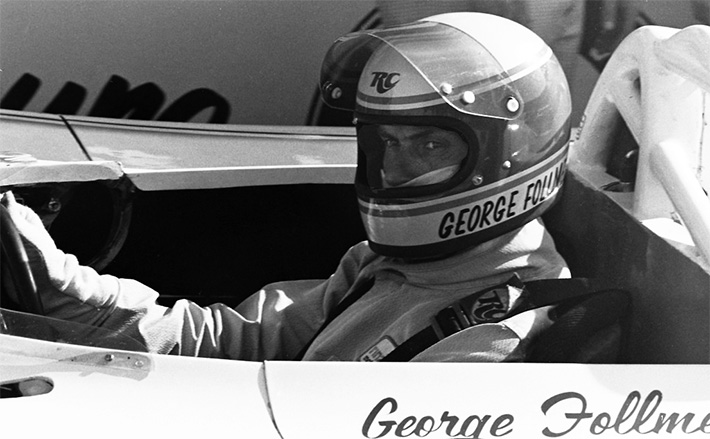George Follmer Biography
Follmer was born in Phoenix on January 27, 1934, but it was not long before his father, an engineer for a company that made flour mills, moved the family to suburban Los Angeles. “I did okay in high school, when I focused on books instead of girls,” Follmer remarks.
He delayed college until he’d served in the Army following the Korean war where he was a company clerk for an intelligence outfit in Bavaria, Germany. After the Army Follmer earned a business degree from Pasadena City College and found work selling fire and casualty insurance, married and became the father of a son and two daughters.
In 1959 Follmer bought a two-year old Porsche Speedster in 1959 and competed in Porsche Club events throughout Southern California. Follmer’s first Porsche carried the number 16, in honor of his son Jim’s birthday, a number which would be his identifier for the rest of his career, whenever that was an option. Through Porsche Club events, he befriended Tom Nuckles, the owner of Trans-Ocean Motors, a Pasadena Porsche dealership.
“Tom was my benefactor and patron. Without him, I wouldn’t have gone anywhere,” Follmer says. “The U. S. Road Racing Championship series caught my eye, so Tom and I decided to see what we could do with a Lotus 23. “The car was bought from Lotus for $4,000 and we had to assemble it ourselves.” The chassis was the perfect choice—the engine, not so much.
“Other Lotus 23 guys like Chuck Parsons, Ed Leslie and Bobby Unser were using Cosworth-Ford engines so, over the winter, we spent $10,000 to buy a new 904 engine from Porsche and made it fit in the Lotus chassis.”
George Follmer – Vintage Motorsports

In mid-1966 he paid $10,000 for a Lola T-70 Mk II chassis with a 333ci Al Bartz-built Chevrolet engine for the new Can-Am series under the John Mecom Racing banner. That first season his best results were a couple of 5th place finishes. The following year he was asked by Roger Penske if he’s drive Mark Donohue’s Camaro in Mid-Ohio’s Trans-Am while Donohue was racing at Le Mans. It was a relationship that would pay dividends in the future.
Trans-Am racing took off in 1968 and Follmer would make a name for himself driving a American Motors Javelin for Jim Jeffords. In 1969 Follmer and Parnelli Jones were paired in the 1969 Trans-Am series for Bud Moore’s Ford Mustang team, Ford being one of five manufacturers supporting the series to varying degrees. Follmer won the Bridgehampton race but reliability issues would compromise their season.
In 1970 Follmer would also drive the ludicrous Shadow “go-kart” designed by Trevor Harris. Firestone built 10-in. diameter front tires for the car. that allowed for a door-stop-shaped body but left no room for the driver;’s feet or a clutch pedal which was hand-operated.
“The front springs looked like engine valve springs and we didn’t yet have gas filled shock absorbers to work with them.” Follmer walked away in the midst of a test session a few days before the Mid- Ohio race…”My career was going good in 1970,” Follmer says. “I knew I’d hurt it if I stayed with this program.”
George Follmer – Vintage Motorsports
Follmer continued his successful career in Trans-Am when lightning struck again when Penske called for Follmer to replace an injured Mark Donohue in the Porsche 917/10. Follmer had become Penske’s super-sub, and the driver knowing the quality of Penske’s efforts was happy to oblige. He was flown down to Road Atlanta, a circuit that he had never seen before.
Follmer recalls.
“That Porsche was Mark’s baby. He’d been deep inside that program since its inception, probably deeper than Porsche’s own people. Everything good about that package was because Mark had re-engineered it that way and made it work. I’ve never been hesitant to jump into a new car and test it, but this wasn’t like anything I’d ever driven.”
Follmer would win at Road Atlanta but things did not go as smoothly at the next race at Watkins Glen where Follmer’s unfamiliarity with the Porsche would come back to haunt him.

Flegl was soon saying that Follmer was no good and it was suggested that Penske get another driver. Told to contact Andretti if he was not available , Porsche would get Jacky Ickx, Roger Penske instead asked Donohue for his opinion.
Donohue suggested that they continue to support Follmer with Donohue later admitting that somewhat selfishly if Andretti or Jackie Ickx got on board he may lose his seat as well. Such is the insecurities that all athletes and drivers share. By Mid-Ohio felt more comfortable in the Porsche and thoughts of his replacement began to subside. Donohue would return later in the season but Follmer would win the 1972 Can-Am Championship.
In 1974 George Follmer was back driving a Shadow but now the much better DN4. His best results were 3 straight 2nd place finishes and he finished 2nd in the Championship for what would be Can-Am’s last season.











